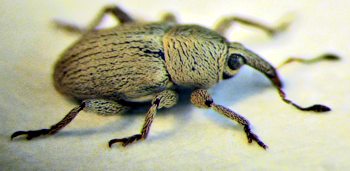Pests
Tychius flavus Becker - Lucerne Seed Weevil.
Synonyms.
Tychius difficilis Tournier.Systematic position.
Class Insecta, order Coleoptera, family Curculionidae, genus Tychius. Closely related to T. junceus Reich.Biological group.
Pest of seed-growing lucerne.Morphology and biology.
Body length is 1.85-2.6 mm. Rostrum in lateral aspect distinctly flattened in apical part. Elytra short-oval. Scales on dorsum broad, elliptical, dense, concealing integument. Fore femora without prominent hairs on underside. Aedeagus parallel-sided, curved dorso-ventrally in apical part. Apex of aedeagus blunted, with hairs on each side. Spring activity of the beetle starts at soil depth of 5 cm with an average temperature near 17°C. In spring the adult feeds on buds and inflorescences and gnaws on leaves, leaving holes. Mating and oviposition begin at the end of May. Female gnaws holes on green beans of lucerne after seeds appear and lays 1 to 3 oblong-ovate eggs inside pods. Females produce 140 eggs on average. Holes on bean pods heal, so infected beans so not appear different from healthy beans. Eggs develop in about 7-10 days. Hatched larvae feed on the inner part of the seeds. Each larva devours 2 to 4 seeds. During the last instar the body length reaches 2.7-4.1 mm. Before pupation the larvae gnaws a hole in pod and falls to the ground. Pupation occurs in soil cradles at depths near 5-10 cm. The pupa develops in 10-20 days. The young beetles stay in the same cradles during hibernation.Distribution.
Inhabits most parts of Europe, Asia Minor, and Central Asia. In the former USSR it is widely distributed in steppe and forest-steppe zones of the European part, in the Caucasus, south-western Siberia, in Middle Asia and Kazakhstan.Ecology.
It is a xerophilous species. It is not abundant in irrigated fields. Every where monovoltine. It occurs regularly in steppe zones on Medicago falcata L. Adults use Melilotus sp. and Onobrychis sp. for additional feeding. The pest appears during the first year of lucerne growing after mid-July. Ants, Dolichopodidae, Chalcidoidea (Habrocytus microgasteris Kurd.; Eupelmus microsomus Forst.; Tetrastichus brevicornis Nees.) are the predators of lucerne seed weevil.Economic significance.
The most harmful pest of seed-growing lucerne. Seed loss caused by T. flavus reaches 5-30%. Control measures include the early cutting of alfalfa before blossoming and pre-winter plowing in autumn when it is humid. Pesticide treatments (2-3 replicates) are necessary in spring after mass emergence of the beetles following hibernation.Reference citations:
Caldara R. 1990. Taxonomic Revision of Palearctic species of the genus Tychius Germar (Coleoptera, Curculionidae). Memorie della Soc. Italiana di Sci. Nat. e del Mus. Civ. di Stor. Nat. di Milano 25(3): 219.Ivanova R.V. 1958. Biological peculiarities of the Lucerne Seed Weevil (Tychius flavus Beck.) and system of its control. PhD Dissertation, Leningrad-Pushkin: VIZR. 18 p. (In Russian)
Karasev V.P. 1992. Weevils of the Genus Tychius Germar (Coleoptera, Curculionidae) of the European part of the USSR and of the Caucasus. PhD Dissertation, Ashkhabad. 24 p. (In Russian)
Kokot O.P., Makhova F.A. 1976. Forecast of lucerne weevils population. Bulletin of All-Union Institute for Maize, Dnepropetrovsk, 3(43): 73-76. (In Russian)
Makhova F.A. 1986. Lucerne Seed Weevil. Zashchita rastenii, Moscow, 5: 59. (In Russian)
Ponomarenko D.A. 1934. Alfalfa seed-destroyers (Tychius flavus Beck. et Tychius femoralis Bris.) and their control in Trans-Volga. Sotsialisticheskoe zernovoe khozyaistvo, 2: 38-57. (In Russian)
Shchegolev V.N., ed. 1955. Agricultural Entomology. Leningrad-Moscow: Gos. Izd. Selskokhoz. Lit. 616 p. (In Russian)


